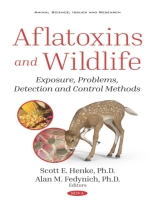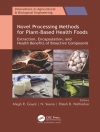Aflatoxins are a highly toxic group of secondary metabolites that are produced by soil fungi, especially Aspergillus spp. fungi. The fungi infect cereal grain crops including corn, wheat, cotton, peanuts, and various other nuts. Aflatoxins can cause serious health concerns because they are known carcinogens, mutagens, teratogens, and immunosuppressive agents. Therefore, limits are in place by the U.S. Food and Drug Administration regarding how much aflatoxin can occur in cereal grain that will be consumed by humans and livestock within the human food chain. Such limits are even stricter in Europe than in the United States. Therefore, aflatoxins, when present in cereal grains, contribute to major economic losses in these commodities. However, to date in the United States, aflatoxin concentrations are not restricted within cereal grain provided to wildlife. Various wildlife agencies and organizations recommend limits in aflatoxin concentrations, but these are only recommendations and not mandated by law. Therefore, grain condemned for human consumption can be marketed as feed for wildlife. Unfortunately, wild animals befall the same health concerns as humans when it comes to aflatoxin exposure. Aflatoxins in Wildlife is a compilation of research concerning the effects of aflatoxin exposure to wildlife by researchers of the Caesar Kleberg Wildlife Research Institute at Texas A&M University-Kingsville. This volume contains sixteen chapters, beginning with a review of aflatoxin, what it is, how it functions in the environment, and its known effects on various species (Chapter One and Two). The book then discusses the potential exposure of wildlife to aflatoxins (Chapter Three), and the prevalence of aflatoxins in feed provided to wildlife (Chapters Four-Six). Chapters Seven-Ten focus on specific effects that aflatoxins have on the physiology of wildlife species, mainly birds, while Chapters Eleven and Twelve research the recovery time needed after aflatoxin exposure and the ability of species to detect aflatoxin within feed. Chapter Thirteen specifically addresses the effects of aflatoxin exposure in wild mammals. The remainder of the book (Chapters Fourteen-Sixteen) focus on testing feed for aflatoxin and how a person can reduce the risk of providing aflatoxin-contaminated grain to wildlife. Aflatoxins in Wildlife is an essential addition to the library of vertebrate and environmental toxicologists, zoonotic disease specialists, veterinary health care professionals, and wildlife biologists. Scott E. Henke is a wildlife research scientist with the Caesar Kleberg Wildlife Research Institute and a Regents Professor and Chair within the Department of Animal, Rangeland and Wildlife Sciences with Texas A&M University-Kingsville. Dr. Henke has more than 150 publications in scientific journals and also is co-Editor of the books Becoming a Wildlife Professional and American Alligators: Habitats, Behaviors, and Threats. Alan M. Fedynich is a wildlife research scientist with the Caesar Kleberg Wildlife Research Institute and a Professor within the Department of Animal, Rangeland and Wildlife Sciences with Texas A&M University-Kingsville. Dr. Fedynich has authored/coauthored more than 70 articles published in peer-reviewed scientific journals. The two researchers have collaborated on numerous zoonotic disease and parasite projects.
Scott E. Henke
Aflatoxins and Wildlife: Exposure, Problems, Detection and Control Methods [PDF ebook]
Aflatoxins and Wildlife: Exposure, Problems, Detection and Control Methods [PDF ebook]
Buy this ebook and get 1 more FREE!
Language English ● Format PDF ● Pages 336 ● ISBN 9781536145793 ● Editor Scott E. Henke ● Publisher Nova Science Publishers, Inc. ● Published 2019 ● Downloadable 3 times ● Currency EUR ● ID 6961952 ● Copy protection Adobe DRM
Requires a DRM capable ebook reader












